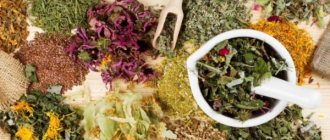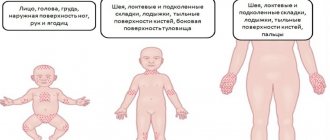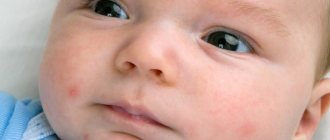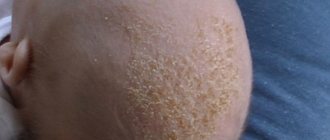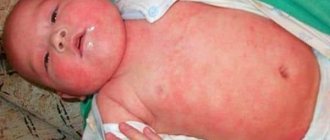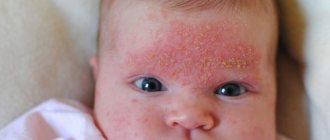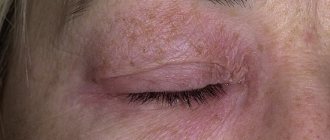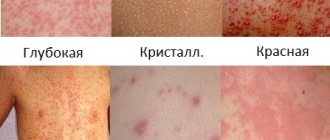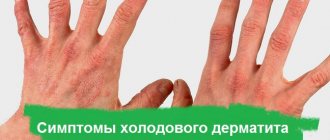The appearance of dermatitis in children is characterized by an inflammatory reaction of the skin as a result of external and internal influences on the body. Seborrheic dermatitis in children is accompanied by the appearance of scaly crusts (gneiss), yellow in color, in the scalp area, which often frightens adults.
You should not be afraid of this, since seborrhea on the scalp in an infant occurs in almost 50% of cases.
It is important to consider that the symptoms of seborrheic dermatitis can be observed not only on the head, but also on the neck, face, and chest area. As a rule, seborrhea is not accompanied by pain and before starting its treatment, you should consult a pediatrician and dermatologist.
Causes
The etiology of the disease is unknown. The main reasons for the development, according to doctors:
- Hereditary predisposition. It is not dermatitis itself that is inherited, but the conditions that contribute to its occurrence. It has been proven that with seborrheic dermatitis, the qualitative chemical composition of the secretion synthesized by the sebaceous glands changes.
- Formation of hormonal levels. In the early neonatal period, hormones received from the mother in utero are present in the blood of newborns. These substances have a stimulating effect on the sebaceous glands: they cause hyperplasia and hyperfunction.
- A decrease in local immunity leads to the activation of yeast-like fungi of the species Malassezia furfur, which are normally present on the skin in the form of spores. These fungi are called lipophilic because they feed on sebum. Rapid growth and proliferation of fungi cause inflammation, and overproduction of the sebaceous glands disrupts the process of physiological rejection of dead epithelial cells. They are glued together by sebum and remain on the skin in the form of scaly-cortical layers.
- Secondary immunodeficiency states as a result of intrauterine infection of the fetus.
- Diseases of the digestive tract associated with malabsorption (lack of microelements and vitamins involved in metabolic processes) or loss of fluid (dehydration).
- Poor nutrition of the mother (abuse of fatty, sweet foods) during lactation or incorrect selection of milk formulas if the child is bottle-fed.
- Frequent acute infectious diseases that weaken the immune system.
- Taking certain medications (glucocorticoids, antibiotics).
- Dysbacteriosis.
- Violations of the rules of hygienic child care, rare bathing.
- Wash your hair daily with allergenic products or soap. In this case, the protective fat film is washed off, which forces the sebaceous glands to increase sebum production.
- Overheating, which leads to increased sweating of the scalp when the child wears caps.
- Low indoor humidity.
What is the danger for the baby?
Seborrheic dermatitis, like any other, must be treated in newborns, since the lack of proper care and poor nutrition will lead to complications. The crusts will spread further; in some children with a genetic predisposition, the development of atopic dermatitis cannot be ruled out.
If inflammatory processes occur on the skin, they can provoke secondary infections - staphylococcal or streptococcal dermatitis will appear. Such diseases already require serious drug treatment.
What it is?
Seborrheic dermatitis is associated with impaired functioning of the sebaceous glands. In this case, sebum is released in large quantities and changes its composition, and its protective properties are lost. Seborrheic dermatitis can appear in absolutely every child. The fungi that provoke it feed on sebum and are located in the places where it is secreted. If the composition of sebum changes, fungi are able to quickly multiply and thicken the stratum corneum of the skin, causing it to peel and lose strands.
The factors that cause seborrhea may vary. It can occur in a child due to completely natural factors, or it can appear after suffering a serious infectious disease. Most often there is a combination of different factors.
Seborrheic dermatitis in infants may differ depending on the form:
- Light form . Crusts, spots, plaques and slight peeling appear, but the general condition of the baby is not disturbed in any way.
- Medium-heavy . Lesions appear on the limbs and torso, where the scales are larger. They can merge and form large lesions. The scalp turns red and masses of scales accumulate there. In this case, you need to consult a specialist.
- Heavy . Characterized by severe skin lesions. 2/3 of its entire area is covered with red spots and is very flaky. Redness is most severe in areas of the skin where there are folds. Wet loosening of the skin and cracks are noticeable. A so-called “cap” appears on the head, which is an accumulation of fatty scales. The child may become lethargic, lose appetite, suffer from diarrhea, and gain less weight than necessary. This condition requires urgent medical intervention.
How is dermatitis treated in adults at home?
Read this article about the causes and treatment of dermatitis on the face.
Causes of seborrhea in infants
In most cases, seborrheic dermatitis in infants is a variant of the physiological form. This is explained by the fact that his skin is very soft and sensitive, and the sebaceous glands are not yet fully functioning.
Between the ages of birth and 1.5 years, seborrheic dermatitis occurs in every 4-5 children. Many doctors attribute the occurrence of such a deviation in a child to the influence of maternal hormones.
Reasons for the development of seborrheic dermatitis in infants:
- heredity;
- use of aggressive cosmetics;
- excessive sweating of the child;
- wrapping and high temperature in the room.
The child does not inherit the disease itself, but only a tendency to increased production of sebum. The use of inappropriate toilet soap and other cosmetics can provoke the development of such a deviation.
Symptoms
The main clinical manifestation of gneiss is the presence of fatty yellowish-white deposits on the crown of the baby around the large fontanel.
The skin underneath is unchanged, sometimes hyperemic. Less commonly, scaly formations are located on the face: on the forehead, near the eyebrows, on the cheeks, on the chin, behind the ears. Itching is absent or very mild. The disease occurs in three forms: mild, moderate and severe.
- In mild forms, seborrhea in infants on the head looks like dandruff. The scales are easily separated from the skin, the epidermis underneath is not changed. There is no itching, the child’s general condition does not suffer.
- The average form is characterized by more extensive skin lesions, the scaly-cortical layers are dense and brown in color. When the crusts are rejected, inflamed, bright red skin is exposed. The pathological process extends not only to the face (forehead, eyebrows, bridge of the nose, temporal areas), but also to the back of the head, neck, torso and limbs. In the photo below you can see the manifestations of seborrheic dermatitis on the face.
- The severe form is characterized by the formation on the scalp of merging powerful scaly-cortical layers that cover the skull in the form of a “seborrheic cap.” The superficial layer of the epidermis is affected. The skin after peeling off the crusts is inflamed, red with areas of erosion and cracks. With this form of seborrhea, a secondary infection may occur. The hair growing in the affected area is also damaged: it becomes brittle and falls out easily. The child's general condition deteriorates significantly: itching, interrupted sleep, poor weight gain, restlessness and frequent crying appear.
What does seborrheic dermatitis look like?
It is easy to identify seborrheic dermatitis in newborns - it is mainly localized on the scalp. The disease develops gradually: first, small pimples and redness due to excessive sweating may appear, then yellowish crusts form, causing itching. In adulthood, the disease manifests itself less frequently, and cosmetic products and fungus are to blame for its occurrence. It is necessary to treat dermatitis not only because of the discomfort and unaesthetic appearance (for example, in the photo), but also to prevent the spread of the disease.
Seborrheic crusts on the head of a baby
Baby milk crusts in the hair are not a sign that the child has a serious illness. Over time, they go away on their own, without special treatment. Seborrheic crust in infants can pass and reappear, being chronic. In this case, the baby requires medical attention and medications aimed at destroying harmful fungi and bacteria.
Seborrheic dermatitis on the body of a child
Seborrhea occurs less frequently on the body of newborns. It looks like a yellow-pink crust with small cracks and can cause redness, itching, and discomfort. Doctors recommend treating damaged areas of skin with a special gel. Under no circumstances should you try to tear off the crusts, soak them, or remove them yourself. Under the keratinized scales is the baby's delicate skin, which is easily damaged. In any case, it is important to take timely measures to prevent the development of the disease.
Why does the disease occur?
In infants, crusts on the scalp can appear under the influence of various factors.
- The main cause of the disease is considered to be hormonal changes. After birth, newborns accumulate hormones in their bodies that they received from their mother during fetal development. In the process of establishing your own hormonal levels, a malfunction may occur, which causes increased work of the sebaceous glands and the formation of crusts on the surface of the head.
- Dermatitis on the head in newborns can appear under the influence of external factors. Hats and bonnets worn during the period after birth lead to increased sweating and the appearance of gneiss. The development of the disease is also influenced by the detergents used when bathing. They dry out the skin, preventing the sebaceous glands from functioning properly.
- On the part of the head where hair grows, crusts may form if a nursing mother violates the rules of nutrition. An incorrectly selected mixture can have the same effect.
- If the fungus Malassezia furfur is attached to the crusting process, the rash may spread to other areas. It often appears on the face, where the skin becomes keratinized.
- The disease can appear in newborns with weakened immune defenses. In this case, it is easier for infections to enter the body, causing dermatitis.
In most cases, treatment for the disease is not prescribed. However, if there are disorders in the immune system, additional therapy may be required.
Constant wearing of bonnets and caps can lead to the appearance of seborrheic dermatitis on the head of a newborn.
Causes of seborrheic dermatitis in young children
If a seborrheic type of skin disease is detected in an adult, this indicates serious problems in the body. Seborrheic dermatitis in a child, especially a newborn, is considered almost normal. While all his organs are imperfect, the same applies to the sebaceous glands.
Doctors can only guess about the exact reason that leads to the activation of Malassezia furfur fungi. The following versions about the development of seborrheic dermatitis have been put forward:
- Hormonal imbalance. After birth, the child's endocrine system begins to form. But its formation is hampered by maternal hormones, which are excreted from the body in the first months of its life. They stimulate the sebaceous glands, which produce an abnormally large amount of secretion during this period. And fungi successfully take advantage of this, receiving fertile soil for nutrition and reproduction.
- Imperfect immune system. A newborn baby is protected only by antibodies that were received from the mother. Your own immunity takes time to develop. Therefore, in the first weeks of life, a weak organism is exposed to a threat from fungi, which have turned from peaceful inhabitants of the skin into aggressors.
- Heredity. If relatives have increased secretion of the sebaceous glands, then it passes to the baby. Excessive amounts of sebum produced lead to the same sad result - seborrheic skin lesions.
- Provoking external factors. Constantly wearing hats causes diaper rash on the baby's head; they are also a good environment for the existence of microorganisms. Using shampoos that dry out the skin leads to the opposite effect: the body strives to make up for the deficiency - the sebaceous glands begin to work at full capacity.
If there are all these factors in the baby’s life, then the risk of developing seborrhea doubles.
Complications
Seborrheic dermatitis of the scalp in babies is a benign disease that often goes away on its own without treatment.
With extensive scaly layers, the hair follicles are also damaged. In such cases, partial alopecia or baldness is possible. After treating seborrhea, hair growth is restored.
But in severe cases, in a weakened child, a secondary infection of the pathological focus occurs with pathogenic bacteria - streptococcus, staphylococcus. Symptoms appear in the form of ulcers on the scalp, which is especially dangerous because the veins located here have anastomoses, that is, they connect to the vessels of the brain. If not diagnosed and treated in a timely manner, this can lead to the occurrence of such serious diseases as meningitis or encephalitis.
Treatment
Treatment consists of eliminating factors that contribute to the chronicity of the process: vegetative-vascular dystonia, diseases of the gastrointestinal tract, liver, foci of chronic infection. It is carried out jointly by several doctors of various specialties depending on the etiology: always a dermatologist, if necessary a pediatrician, gastroenterologist, endocrinologist, gynecologist, urologist and neurologist - and only under their supervision.
After a diagnosis of seborrhea is established, it is recommended to follow a dietary diet that is limited in carbohydrates, fats and salt, rich in fiber, vitamins and dairy products.
The baby requires careful care. When the first symptoms appear, contact of synthetic fabrics with the baby’s skin should be avoided, opting for natural things without seams.
- In women, combined oral contraceptives are used in cycles with an interval of 7 days to normalize hormonal levels.
- Vitamins A, C, E and group B are prescribed immediately after diagnosis.
- The trace element zinc is used in tablet form, 1 tablet three times after meals for 1-2 months.
- For dermatitis of the scalp, antifungal drugs are recommended, especially if fungi of the genus Pityrosporum have been found to influence the process. They are applied topically as a cream, shampoo or ointment. Additionally, local antiseptics are prescribed - tar soap, zinc paste. If the above is ineffective, you need to switch to taking glucocorticosteroids.
- If the skin of the face or behind the ears is affected, “Zinerit” ointment or “Dalacin-T” gel is used for a long time.
- When washing your hair, use special medicated shampoos (Nizoral, Sulsen, Danex), sulsen paste and soap.
Traditional methods of treatment and prevention
The most popular and effective method is treatment with sea salt. First, dirt is removed from the head and hair with any shampoo, and then salt is rubbed into wet hair for a couple of minutes. This helps stop hair loss and increases the volume of blood flowing to the hair follicles. For prevention, this technique is indicated once every 1-2 weeks.
Apple cider vinegar is also used, as it contains vitamins, pectin, and enhances regeneration. You can use it as a hair rinse: dissolve 4 tablespoons of a 6% vinegar solution in a glass of clean distilled water. Rinse your hair several times, then rinse off the residue with water. There are also several options for masks:
- Vinegar applied to a cloth is applied to the scalp for 20 minutes and then washed off.
- Add two tablespoons of vinegar and chamomile decoction or castor oil to water at room temperature. Then they apply it to the head and cover it with a bag. After an hour, wash off with water.
Both masks are used for a month, twice a week.
Another home treatment option is to use a beaten egg mixed with 1 spoon of mayonnaise, sunflower oil and honey, rubbed into the scalp for half an hour.
Diagnostics
The diagnosis is made on the basis of characteristic clinical symptoms: localization of pathology in the scalp in the form of scaly formations. Peeling on the face is finely lamellar, with whitish scales.
In unclear cases, diagnosis is carried out by a dermatologist. Using a dermatoscope under multiple magnification, pathological lesions on the skin are studied and microscopy of scales is performed.
If seborrheic dermatitis does not go away in the first year of life, but continues to progress, differential diagnosis with atopic, allergic dermatitis and psoriasis is necessary.
Diagnostics and therapy
Physiological seborrheic dermatitis in infants, caused by the presence of residual maternal hormones, does not require special treatment and goes away on its own by 6-9 months of life. It does not cause any discomfort to the child; the only unpleasant effect is cosmetic. In this case, it is enough to comb out the “baby scabs” little by little regularly and gently before and after bathing.
Under no circumstances should seborrheic crusts be scraped off so as not to damage the baby’s skin!
If redness appears, the skin reaction requires differential diagnosis with infectious diseases, atopic dermatitis, lichen or childhood psoriasis. For this purpose, the mother should contact a pediatrician and dermatologist.
The diagnosis is established on the basis of a clinical examination, as well as laboratory tests:
- macro- and microscopy of crust scraping;
- microbiological seeding of material obtained from scraping;
- in rare cases, a skin biopsy.
In addition, to confirm the diagnosis, the baby’s hormonal levels are determined.
Only moderate and severe forms of dermatitis require specific treatment, so it is very important to strictly follow all the specialist’s recommendations.
Therapy
There is no drug treatment for seborrheic lesions in infants. The famous pediatrician Dr. Komarovsky advises parents to provide their child with comfortable living conditions for any type of dermatitis: a certain temperature and humidity of the room.
Light forms of gneiss are physiological and do not require treatment. It is only necessary to establish proper hygienic care for the child.
To cleanse the epidermis of crusts, the following procedures are used:
- An hour before bathing, lubricate the scalp with olive, burdock or any other vegetable oil and put on a cotton cap. After bathing, carefully remove softened crusts with a brush. Manipulation should be carried out daily until the crusts completely disappear.
- Wash your hair with antifungal shampoos: Nizoral, Sebulex, Ionil. You can use them 2 times a week.
- The scalp is lubricated with a drying cream: Friderm, Bioderma, Zinc ointment.
- Bioderma Sensebio DS+ healing cream is applied in a thin layer to dry skin and not washed off. It has anti-inflammatory and fungicidal effects, regulates sebum synthesis. Particularly effective when used on the face.
- The scales can be removed by applying baby cream at night. In the morning, the head is washed with shampoo, the hair is carefully combed with a soft massage brush.
For bacterial infection, antibiotic therapy or systemic medications (tablets, injections) are prescribed.
If, despite the measures taken, scaly rashes do not decrease or other skin elements (papules, vesicles) appear that are not characteristic of seborrhea, you should consult a doctor.
Symptoms of seborrheic dermatitis
As a rule, seborrhea in infants occurs on the head, and to determine it, you do not need to conduct complex studies - a visual examination of the scalp and observation of the baby’s behavior is enough. Dermatitis causes severe itching, which may cause your baby to cry frequently, rub their head against the pillow, and generally show discomfort. If you notice this behavior, examine the baby's skin and hair; treatment with a special baby cream or gel may be required.
Symptoms of seborrhea:
- formation of hard crusts of yellow-pink color;
- small pimples, prickly heat;
- red spots, irritation on the skin;
- dandruff.
If you are not sure that slight peeling and irritation on your baby’s skin is seborrheic dermatitis, look for a photo and compare the problem. Your baby may simply have irritation or an allergy to a product, rather than dermatitis. In any case, only the attending pediatrician can observe the child and give recommendations on treatment, prescribe medications and ointments.
How to remove crusts on a baby's head
Many mothers unknowingly try to tear off dry scabs, which is strictly forbidden to do, because underneath there is delicate, unprotected skin that can be damaged from rough impact. It is better to purchase a specialized remedy for crusts on a baby’s head at a pharmacy or Vaseline oil, after consulting with a pediatrician. If the growths do not cause discomfort to the child, they do not need to be removed.
Shampoo for seborrheic crusts for infants
In most pharmacies today you can easily buy shampoo for newborns against seborrheic crusts. It helps soften unpleasant formations during bathing and remove them without harming the baby's delicate skin. You cannot use products intended for adults, because a child has a completely different hormonal profile, and the skin is more sensitive to the effects of the components.
- What diet pills really help?
- How to use facial concealer
- How to stay on your diet: 15 ways
Comb for combing out crusts
If you decide to follow the advice of grandmothers and comb out the growths, remember to be careful. Any mechanical impact can lead to injury, so a comb for combing out crusts in infants should be made of natural soft bristles. She will carefully remove the scales without affecting the delicate skin underneath. You will have to be patient, because it is unlikely that you will be able to remove the crusts in one go.
Oil for removing seborrheic crusts
As an aid, you can use cleansing oil to remove seborrheic crusts. It is applied to the affected areas, easily softens the scales, and helps remove them. To make the product work better, you can put a fabric cap on your baby, this will also help to avoid greasy stains on the pillow. After using the oil, you just need to wash your hair with shampoo.
Treatment for infants
Initially, the child develops several small milky crusts on the head; they go away on their own and do not cause discomfort. If seborrhea develops at an accelerated pace, you should consult a doctor so that he can select treatment.
Scraping off seborrheic crusts with a sharp object is strictly prohibited. The skin of a newborn is quite delicate, so it can be easily injured, and this will lead to the development of an infectious process.
Drug treatment involves taking the following medications:
- sedatives;
- antifungal;
- general strengthening;
- vitamin complexes;
- biogenic stimulants.
In parallel with taking medications internally, the use of external agents is prescribed. It is recommended to use shampoo containing tar, zinc and ketoconazole. The following external remedies are effective in the treatment of seborrheic dermatitis:
- Sulfuric ointment;
- paste and sulfur soap;
- olive or baby oil;
- tar-based products.
As an additional effect for seborrhea on the head, cryomassage is recommended. Procedures such as laser puncture and darsonvalization are quite effective.
During treatment, it is necessary to pay special attention to the child’s diet. If the baby is breastfed, then the mother needs to give up canned, salty and fatty foods. The diet should contain a large amount of fruits, vegetables and foods that are rich in fiber, vitamins and beneficial minerals.
It is important to follow all hygiene rules. It is necessary to cleanse the baby's skin of dirt, peeling and crusts. Overheating should not be allowed; the baby should always be dressed for the weather.
Folk remedies
Seborrheic dermatitis can be treated with decoctions of medicinal plants after consulting a doctor.
Recipes:
- Take 15 g of dry roots of burdock, elecampane, and St. John's wort flowers. Place a tablespoon of the mixture in a thermos and add a glass of boiling water. After 8 hours, strain. After each shampoo, rub the infusion into the affected areas.
- Place 20 g of dry sage herb in a container, add 200 ml of hot water, boil for 15 minutes. After cooling and straining, moisten the skin daily in areas where crusts have accumulated.
- Pour 25 g of crushed oak bark into a saucepan, add 200 ml of boiling water, keep in a water bath for 5 minutes. Leave for 3 hours. Strain and rub the broth into sore spots.
- Make a mixture of equal parts of plantain leaves, calendula and chamomile flowers. Pour a tablespoon of the mixture into a thermos with 300 ml of boiling water. Leave for 3 hours. Use a gauze swab dipped in liquid to wipe the affected areas.
Traditional methods are effective when used regularly. Before using herbal infusions in a child, you should make sure that there is no allergy to a particular remedy . To do this, attach a cotton pad soaked in a herbal infusion to the inner surface of the baby’s arm near the wrist with an adhesive plaster. If the skin does not turn red after 24 hours, you can use the test product for treatment.
Reasons for appearance
Many scientists working on the study of this disease believe that it may be caused by the concentration and content of certain hormones that have not yet left the child’s body after he is born. They can more actively stimulate the work of the sebaceous glands, the secretion of which forms the crust.
Other causes of seborrhea in infants:
- genetic predisposition to all kinds of allergic reactions and can precede infectious diseases. Treatment is usually accompanied by taking anti-dysbacteriosis medications and others that regulate the functioning of the gastrointestinal tract.
- The main cause of the disease in children remains the yeast fungus Malassezia furfur. After all, the body still does not work well on its own, and as soon as a malfunction occurs, it immediately begins to multiply on the surface of the skin, where the optimal temperature is where oxygen is available.
Usually, after several months of treatment, seborrheic dermatitis disappears completely, but every rule has exceptions, so the manifestation of the disease can drag on for up to several years.
The disease can also sometimes appear in adolescents. The cause may be a parental allergy that is inherited, or the pregnancy was accompanied by complications. The disease can be provoked by improper feeding or poor conditions created for the child. Also, one should not discount all kinds of chemicals that city life is now full of, exhaust gases, dyes (including food dyes).
Causes of gneiss
Seborrhea is commonly called a pathological increase in the production of secretions from the sebaceous glands located in the skin. Gneiss in infants is a yellow “postpartum”, “milky” crust on the head that disappears on its own during the first few months of life.
It is considered as a physiological norm and its minor presence should not worry parents too much.
The main reason for increased sebum secretion is hormonal fluctuations. That is why seborrheic dermatitis appears not only on the face and head of infants, whose bodies are initially filled with maternal hormones, but also in adolescents who have entered puberty.
But in some cases, the skin lesion is so severe that not only the entire scalp, but also the behind-the-ear and parotid areas, as well as the face are covered with crusts.
In addition, there are a number of other reasons that can strengthen and even disrupt the functioning of the sebaceous glands:
- An unbalanced diet of a nursing mother with a predominance of sweet, fatty, as well as salty and spicy foods.
- Abrupt, incorrect introduction of complementary foods. Since the baby’s body may react to a new product in a completely different way than we expect, untimely or too abundant complementary feeding results in allergic dermatitis followed by seborrhea. In such cases, it is necessary to temporarily stop complementary feeding, or replace the newly introduced product with another, as well as adjust the diet of both the baby and the nursing mother.
- Inappropriate hygiene products for babies or violation of its rules. Shampoo and soap that are used to bathe a child must have an appropriate quality certificate, be dermatologically tested, and must not contain fragrances or other components that can cause various manifestations of allergies.
- The parents' desire to wrap the baby warmly leads to overheating, which causes the sebaceous and sweat glands to become activated, the pores become clogged, and the baby becomes covered with seborrheic crusts. It is enough to remember that the baby needs to be dressed comfortably, observing the “own clothes +1” principle.
- Treatment with hormonal drugs or antibiotics can also cause seborrhea.
The above-mentioned reasons can cause seborrheic dermatitis on their own, but in addition, metabolic disorders and increased sebum secretion create excellent conditions for the reproduction and active growth of Malassezia furfur - representatives of yeast-like fungi. In this case, we are talking about the mycoid etiology of this disease.
Prevention
To prevent seborrheic dermatitis, you must adhere to the following rules:
- During pregnancy, the expectant mother should lead a healthy lifestyle with good nutrition, avoid stress and contact with infections.
- Strictly follow all hygienic measures to care for the baby.
- When bathing your baby, use only hypoallergenic, fragrance-free baby soap.
- Avoid overheating the scalp by wearing numerous hats and scarves. At home, the baby's head should be open.
Seborrheic dermatitis is not a dangerous disease, but it is still not worth treating a child on your own without consulting a doctor.
Under the mask of harmless dandruff, other childhood dermatoses (atopic dermatitis and psoriasis) can be hidden, which without timely treatment become chronic forms that significantly worsen the child’s quality of life.
Treatment of the disease
As a rule, seborrheic dermatitis is not dangerous and correct therapeutic measures and adherence to preventive recommendations lead to positive results and the absence of relapses for a long time.
The treatment regimen is prescribed directly by the doctor, since self-administered measures can provoke complications of the disease. Treatment of seborrheic dermatitis in children primarily involves measures to normalize the functioning of the sebaceous glands.
In addition, it is recommended:
- mild degrees of the disease can be treated with external medications. The use of various products intended for baby care (foam, shampoo, gel, etc.) is allowed. The most commonly prescribed foam shampoos are Friederm, Mustela Bebe, etc.;
- It is prohibited to treat the affected area of a newborn suffering from seborrheic dermatitis with baby soap. In addition, shampoo intended for adult patients should not be used;
- When removing gneiss from the head, water procedures using a herbal decoction with chamomile flowers, string, young nettle, etc. are effective;
- After the crusts have softened, they must be smeared with sterile baby oil (you can boil regular olive oil), after which it is recommended to remove seborrheic crusts from the child’s head with a fine-tooth comb. You should not be afraid of this procedure, since this manipulation is absolutely painless. If this procedure is not performed, the risk of developing inflammatory diseases increases;
- quite often, with the development of an oily form of seborrheic dermatitis in the face and head, drugs with the addition of zinc are prescribed externally, which have a drying and anti-inflammatory effect on the affected areas of the skin;
- To cleanse the face and head area of newborn babies, it is recommended to use Saforel, Sensebio Bioderma, etc. In addition, if necessary, antifungal therapy is prescribed, aimed at suppressing fungal microflora;
- It is important to remember that seborrheic dermatitis in infants is not life-threatening and if all recommended measures are followed, negative symptoms disappear within 2-3 weeks. However, you cannot treat dermatitis on your own, since there is a possibility that similar symptoms can be observed in other diseases. Therefore, it is necessary to consult with your doctor.
Causes
For what reason does seborrhea develop on a child’s head? As mentioned above, seborrhea in a child is formed due to a malfunction of the sebaceous glands. In newborns, this defect appears in the third week of life and completely disappears by the third month. But it is important to remember that when seborrhea occurs, it is necessary to regularly perform hygiene procedures in order to avoid aggravation of the process.
This is how seborrheic dermatitis may look on a child’s face.
As for the reasons why seborrhea of newborns appears, there are several:
- hormonal activity transmitted from mother to child. When hormones are activated, the secretion of glands increases;
- predisposition to the allergic cascade;
- dysbiosis and malfunction of the gastrointestinal tract;
- previously suffered infectious pathologies;
- activation of the fungus when the body’s protective functions are weakened;
- improper care, overheating of the baby, causing excessive sweating;
- CNS disorders and neurotic conditions;
- poor nutrition.
Seborrhea in children on the head is not a contagious pathology and is not transmitted through household contact. You cannot become infected with this defect through airborne droplets.
